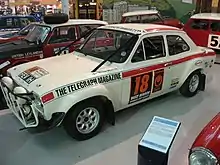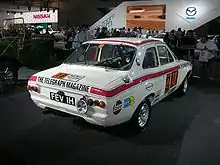1970 London to Mexico World Cup Rally
The 1970 London-Mexico World Cup Rally was the first of two World Cup Rallies to be held and the second of four marathon rallies to be held in a nine-year period beginning with the 1968 London-Sydney Marathon. The motor rally started at Wembley Stadium in London on 19 April 1970 and finished in Mexico City on 27 May 1970, covering approximately 16,000 miles (25,700 km) through Europe and South America. It was won by Hannu Mikkola and Gunnar Palm, driving a Ford Escort.
| 1970 London to Mexico World Cup Rally Daily Mirror World Cup Rally | |
|---|---|
| Host country | |
| Rally base | London Mexico City |
| Dates run | 19 April – 27 May 1970 |
| Stages | 32 |
| Stage surface | Tarmac and Gravel |
| Overall distance | 25,700 km (16,000 miles) |
| Results | |
| Overall winner | |
| Crews | 96 at start, 23 at finish |

Organisation
The event was the brainchild of Wylton Dickson, possibly inspired by the earlier 1968 London-Sydney Marathon, and was to mark the fact that the 1966 FIFA World Cup had been held in London and that the upcoming 1970 FIFA World Cup was to be held in Mexico. Dickson approached the renowned British rally driver Paddy Hopkirk and together they went to The Daily Mirror for sponsorship.
Route and scoring
The course covered approximately 16,000 miles (25,700 km) through Europe, South America and Central America. Two boats were need to convey the rally, one to cross the Atlantic Ocean from Lisbon to Rio de Janeiro and a second from Buenaventura, Colombia across the Gulf of Panama to Panama to avoid the impassable Darién Gap. Some of the principal towns and cities visited were, in order:[1]
- London, England
- Dover, England
- Boulogne-sur-Mer, France
- Mannheim, Germany
- Munich, Germany
- Vienna, Austria
- Budapest, Hungary
- Belgrade, then in Yugoslavia, now in Serbia
- Sofia, Bulgaria
- Trieste, Italy
- Venice, Italy
- Genoa, Italy
- Toulouse, France
- Pau, France
- Burgos, Spain
- Salamanca, Spain
- Lisbon, Portugal
- Rio de Janeiro, Brazil
- Montevideo, Uruguay
- Buenos Aires, Argentina
- Bariloche, Argentina
- Santiago, Chile, Chile
- La Paz, Bolivia
- Lima, Peru
- Cali, Colombia
- Panama City, Panama
- San José, Costa Rica
- Mexico City, Mexico
The course included many special stages, some over 500 miles (800 km) long. Time penalties were given for exceeding set times on the special stages, as well as for other infractions of the rules, and the cars' positions determined by the penalties awarded rather than lowest cumulative times.
Cars

Over one hundred cars started the event. The rules about what cars could be entered were not restrictive but due to the demanding nature of the course most competitors were conservative and used modified versions of standard models. That did not prevent there being a wide variety of cars, from Volkswagen Beetles to Rolls-Royces. There were works (officially sanctioned and prepared) entries from Ford, British Leyland and Moskvitch, and semi-works entries from Citroën.
The Ford team ran modified Escort Mk Is, fitted with an 1850 cc version of the crossflow Kent engine and uprated with various other parts from other Ford models. Each Ford car had two drivers. The British Leyland team entered two teams. The first team ran three Triumph 2.5PI Mark 2s, which were more powerful than the Fords but were significantly heavier; two cars carried a three-man crew, Brian Culcheth preferring to stick with a conventional two-man crew. The second Leyland team ran Austin Maxis, Austin 1800s (some badged Morris) and a lone Mini Clubman. Citroën used the venerable DS21. Moskvich used the Moskvich 412 with 1500 cc engine.
Other cars run in the event included:
Competitors
Many rally drivers of the day entered the event, including:
- Rauno Aaltonen
- Roger Clark
- Andrew Cowan (winner of the 1968 London-Sydney marathon)
- Brian Culcheth
- Tony Fall
- Paddy Hopkirk
- Timo Mäkinen
- Hannu Mikkola
- Jack Murray
- Gilbert Staepelaere
- Rene Trautmann
- Guy Verrier
- Gastón Perkins
- Jose Migliore
- Alcides Rodriguez (Peugeot #33)
- Henri "Ido" Marang, who was killed in the crash of his Citroen on May 25, two days before the race's end. His co-driver, Paul Coltelloni survived but was seriously injured. [2]
As well as professional rally drivers, the event attracted a number of well known people, including the footballer Jimmy Greaves, who finished a very creditable sixth, and HRH Prince Michael of Kent, who failed to finish.[1]
Results
| Pos | No | Entrant | Drivers | Car | Penalties (Time) |
|---|---|---|---|---|---|
| 1 | 18 | Ford Escort 1850 GT Mark I | 9hr 7min | ||
| 2 | 88 | Triumph 2.5 PI Mark II | 10hr 25min | ||
| 3 | 46 | Ford Escort 1850 GT Mark I | 10hr 46min | ||
| 4 | 98 | Triumph 2.5 PI Mark II | 12hr 26min | ||
| 5 | 103 | Ford Escort 1850 GT Mark I | 14hr 31min | ||
| 6 | 26 | Ford Escort 1850 GT Mark I | 19hr 31min | ||
| 7 | 100 | Citroën DS 21 | 22hr 3min | ||
| 8 | 14 | Ford Escort 1850 GT Mark I | 23hr 59min | ||
| 9 | 54 | BMC 1800 | 24hr 42min | ||
| 10 | 74 | Austin Maxi | 30hr 35min | ||
| 11 | 32 | Austin Maxi | 32hr 36min | ||
| 12 | 28 | Moskvitch 412 | 34hr 6min | ||
| 13 | 29 | BMW 2002 Ti | 35hr 14min | ||
| 14 | 15 | Ford Cortina GT Mark II | 36hr 43min | ||
| 15 | 83 | Hillman Hunter | 37hr 50min | ||
| 16 | 38 | Mercedes-Benz 280 SE | 38hr 5min | ||
| 17 | 71 | Moskvitch 412 | 38hr 52min | ||
| 18 | 91 | BMC 1800 | 39hr 16min | ||
| 19 | 66 | Peugeot 404 | 40hr 46min | ||
| 20 | 19 | Moskvitch 412 | 41hr 5min | ||
| 21 | 31 | Datsun 1600 SSS | 46hr 1min | ||
| 22 | 96 | Austin Maxi | 46hr 25min | ||
| 23 | 45 | Ford Escort 1300 GT Mark I | 66hr 8min | ||
| Source:[3] [4] | |||||
References
- World Cup Rally, Graham Robson, The Car magazine no. 25, 1985, Orbis Publishing Ltd.
- "French Pilot, Marang, Dies In World Cup Rally Crash", Indianapolis Star, May 26, 1970, p26
- Philip Young & Ted Taylor. "Final Entry List".
- Graham Robson, The Daily Mirror World Cup Rally 40: The World’s Toughest Rally in Retrospect, 2010, pages 195-196
External links
- London-Mexico: The Complete Story, transcription of an article in the French magazine L'Auto Journal (in French)
- WCR40: The 40th Anniversary Event, The site for the reunion of all surviving cars, crews, mechanics, organisers and associated personnel to be held in April 2010. Now a part of the Heritage Marathon Rally Group website.
- Lotus Cortina to Mexico, The story of the Cal Withers entered Lotus Cortina in the 1970 event